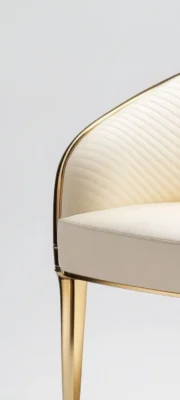Style
THE FUTURE OF LUXURY FURNITURE
In a world that’s constantly evolving, the future of luxury furniture is being reshaped by innovation, sustainability, and a desire for self-expression. As consumers grow more conscious of their choices and demand personalized experiences, the industry is responding with a bold new vision—one that fuses technology, individuality, and nature into timeless, elegant design.
Technology Redefining Craftsmanship
Also мodern technology is revolutionizing how luxury furniture is designed, produced, and experienced. From AI-assisted design software to 3D printing and smart home integration, high-end pieces are now crafted with unprecedented precision and functionality. Smart materials that adapt to climate, lighting systems embedded into headboards, or coffee tables with wireless charging are no longer futuristic concepts—they’re becoming the new standard in luxury living.

The Rise of Individuality in Design
One-size-fits-all is a thing of the past. The new generation of consumers values individuality—they want furniture that reflects their personality, lifestyle, and values. Bespoke pieces, customizable finishes, and artisanal detailing are now central to the luxury experience. Brands are offering collaborative design opportunities where clients become co-creators, ensuring that every piece tells a unique story.
In the world of luxury, individuality is no longer optional—it’s essential. Today’s consumers want furniture that reflects who they are, not just how their space looks.
Key Trends Shaping the Future:
- First is Customization: From materials and colors to shapes and finishes, every detail can be tailored.
- Second Client Collaboration: Customers are becoming co-creators, using design tools and working directly with designers.
- Next is Artisanal Craftsmanship: Handcrafted pieces bring uniqueness, story, and soul into the home.
- And finely Exclusivity: Limited editions and one-of-a-kind pieces define modern luxury.
Luxury furniture is no longer just about aesthetics—it’s about identity.

A Return to Nature
Sustainability is no longer optional — it’s essential. In fact, today’s luxury is deeply intertwined with nature. As a result, designers are turning to natural, renewable materials like reclaimed wood, bamboo, stone, and organic textiles. Moreover, earth-toned palettes and biophilic design — incorporating elements like indoor gardens, natural light, and plant-based textures — are becoming increasingly popular. Ultimately, this connection to nature brings a sense of calm and timelessness to modern interiors.
Use of Natural & Renewable Materials
To begin with, materials such as reclaimed wood, bamboo, rattan, cork, stone, and organic cotton or linen are becoming the materials of choice.
Not only do these materials reduce environmental impact, but they also add warmth and authenticity to interiors.
Biophilic Design Elements
In addition, biophilic design encourages the integration of plants, living walls, and water features into luxury spaces.
Furthermore, there is a strong emphasis on natural light, open spaces, and seamless transitions between indoors and outdoors.
Earth-Toned Color Palettes
Inspired by nature, color schemes now feature soft greens, sandy beiges, deep browns, stone greys, and ocean blues.
As a result, they create a calming, grounded atmosphere that never goes out of style.
Craftsmanship with Ecological Responsibility
Meanwhile, many luxury brands are focusing on ethical sourcing and low-waste production practices.
Consequently, there is increasing demand for handmade, slow-crafted furniture with a meaningful, sustainable story.

The future of luxury furniture lies at the intersection of technology, individuality, and nature. It’s a world where each piece is an experience—a reflection of the owner’s identity, values, and the modern desire for both comfort and meaning. As the lines between design, lifestyle, and innovation continue to blur, one thing remains clear: true luxury is about more than status—it’s about connection, creativity, and conscious living.

